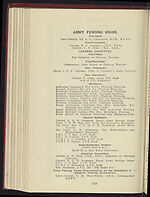1935-36
(281)
Download files
Complete book:
Individual page:
Thumbnail gallery: Grid view | List view

E
i
�I
f
FENCING.
H 19tory.
The Army Fencing Union was founded on July 9th, 1919, the
inaugural meeting being held at the Royal Tournament, Olympia,
under the presidency of Lieut.-General Sir A. E. Codrington,
K.C.V.O., C.B., who has been President of the Union ever since.
The meeting was attended by representatives from Army
Commands and by several prominent Army fencers. The objects
of the Union were approved and the rules for its government were
drawn up. The objects and rules have required very little
alteration since they were originally decided on and are set out
fully in the rules given below.
In 1922 it was found that although the Union was functioning
satisfactorily, it did not quite meet the needs of the growing body
of fencers in the Army; few matches were possible, and the fact
that representative teams were chosen gave very little chance of
practice to less expert fencers. It was therefore decided, in
November, 1922, to form an Army Fencing Club as a subsidiary
club to the Army Fencing Union, and to charge a subscription for
membership of the Club. The Club fought its first match on
6th December, 1922. During the fencing season 1922-23, it was
found that owing to the similarity of names of the Union and
Club, confusion sometimes arose, and it was therefore decided to
alter the name of the Club. Members were asked to send in
suggestions, and at a meeting held on 5th May, 1923, the name
of the " Masks Fencing Club " was adopted. That the Club has
flourished may be deduced from the fact that the original fixture
list of the 1922-23 season contained 16 fixtures, while that for the
present season contains no less than 40. Membership of the Club
has increased from 80 in 1922 to 130 at the present time.
RULES OF THE UNION.
Name.
1. The Union to be called the " A
RMY
F
ENCING
U
NION."
Objects.
2. (a) To improve the skill-at-arms of the British Army by
means of establishing all forms of fencing as a sport throughout
the Army.
(b) To work in accordance with the policy of the Army Sport
Control Board in the encouragement of all forms of fencing in
the Army.
(c) To act as a Central Governing Body for fencing in the Army.
(d) To represent Army views on Inter-Service and Amateur
Fencing Association Committees.
(e) To arrange and select teams for Inter-Service and other
representative matches.
239
4
i!
i
�I
f
FENCING.
H 19tory.
The Army Fencing Union was founded on July 9th, 1919, the
inaugural meeting being held at the Royal Tournament, Olympia,
under the presidency of Lieut.-General Sir A. E. Codrington,
K.C.V.O., C.B., who has been President of the Union ever since.
The meeting was attended by representatives from Army
Commands and by several prominent Army fencers. The objects
of the Union were approved and the rules for its government were
drawn up. The objects and rules have required very little
alteration since they were originally decided on and are set out
fully in the rules given below.
In 1922 it was found that although the Union was functioning
satisfactorily, it did not quite meet the needs of the growing body
of fencers in the Army; few matches were possible, and the fact
that representative teams were chosen gave very little chance of
practice to less expert fencers. It was therefore decided, in
November, 1922, to form an Army Fencing Club as a subsidiary
club to the Army Fencing Union, and to charge a subscription for
membership of the Club. The Club fought its first match on
6th December, 1922. During the fencing season 1922-23, it was
found that owing to the similarity of names of the Union and
Club, confusion sometimes arose, and it was therefore decided to
alter the name of the Club. Members were asked to send in
suggestions, and at a meeting held on 5th May, 1923, the name
of the " Masks Fencing Club " was adopted. That the Club has
flourished may be deduced from the fact that the original fixture
list of the 1922-23 season contained 16 fixtures, while that for the
present season contains no less than 40. Membership of the Club
has increased from 80 in 1922 to 130 at the present time.
RULES OF THE UNION.
Name.
1. The Union to be called the " A
RMY
F
ENCING
U
NION."
Objects.
2. (a) To improve the skill-at-arms of the British Army by
means of establishing all forms of fencing as a sport throughout
the Army.
(b) To work in accordance with the policy of the Army Sport
Control Board in the encouragement of all forms of fencing in
the Army.
(c) To act as a Central Governing Body for fencing in the Army.
(d) To represent Army views on Inter-Service and Amateur
Fencing Association Committees.
(e) To arrange and select teams for Inter-Service and other
representative matches.
239
4
i!
Set display mode to:
![]() Universal Viewer |
Universal Viewer | ![]() Mirador |
Large image | Transcription
Mirador |
Large image | Transcription
| Games and sports in the army > 1935-36 > (281) |
|---|
| Permanent URL | https://digital.nls.uk/248712023 |
|---|
| Description | 'Games and Sports in the Army' was an annual publication produced by the British War Office between the 1930s and 1960s. This included the Second World War. It outlines the rules and regulations for games and sports played by members of the armed forces. It features names and photographs of team members, and examples of contemporary advertising. |
|---|---|
| Shelfmark | GWB.52 |

